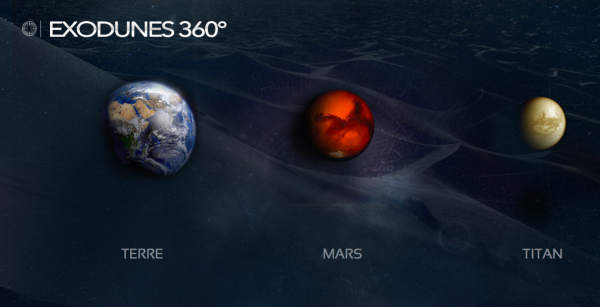Caractérisation des dunes EXtra-terrestres de Mars et Titan.
Characterising extra-terrestrial dunes on Mars and Titan.
Completed project
Porteur CEA : S. Rodriguez
The scope of the EXO-DUNES project is to document dune features as well as the atmospheric and sedimentary processes that created and shaped them on Mars and on the Saturn’s moon Titan.
Thanks to the actual programs of extensive observation and exploration of Mars and Titan, our knowledge of these planetary bodies has greatly improved. Atmospheric phenomena and landscapes on Mars and Titan bear striking resemblance with those on Earth. In particular, extensive dune fields were observed on these distant bodies, showing that dunes can form throughout the solar system under extremely various planetary environments. Dunes provide a powerful tool to investigate the sedimentary and climatic history of arid and semi-arid environments (such as on Earth deserts, and more globally on Mars and Titan).
Mars and Titan have both “exotic” environments, but only subtle differences in dune morphologies compared to terrestrial standards. Martian dunes are thought to be formed in frozen environments and their morphogenesis and evolution should be, at least partially, controlled by surface and sub-surface processes, such as local topography, volatile concentration in the sediment and frost/defrost cycles. Farther away from the Sun, the origin and morphogenesis of Titan’s dunes is still poorly understood, but the climate of Titan and the nature of the hydrocarbons “grains”, suggest that the inter-grain cohesion may play a major role. However, despite intensive studies of planetary dunes, many questions regarding their origins, composition, morphology, age and dynamics under present and past climatic conditions remain unanswered. Hence, Mars and Titan provide a unique opportunity to constrain dune morphodynamics under extreme environments and to improve in turn our current understanding of terrestrial atmospheric and surface processes.
We propose to study in details the dunes of Mars and Titan, with the help of Earth’s relevant analogs, when available. The objective of this project is to develop new quantitative methods in order to disclose the fundamental information about the nature of the sediment and the atmospheric wind regimes that are contained in the morphology, size and orientation of dunes. We identify three specific, but essential questions about the morphogenesis and evolution of dunes on Mars and Titan:
(1) what is the origin and role of the inter-grain cohesion?
(2) what is the role of topography?
(3) what are the role of the variability of the wind in intensity and direction?
However, the observation of dune shapes and orientations alone is not sufficient to resolve the ambiguity between the combined roles of the atmospheric flows and the grain mechanical properties. Transport laws, wind regimes and sediment properties being highly non-linearly coupled, this exercise turns out to be an inverse problem of a vast intrinsic complexity. EXO-DUNES is therefore a highly collaborative and interdisciplinary project, bringing together researchers with interests in planetary dunes and with diverse backgrounds in image analysis, experimental researches, modeling, and terrestrial analogue studies.
The first part of this project is to analyze images and topography of planetary dunes on Mars and Titan and to quantitatively study their morphodynamics (composition, shape, orientation, migration direction and velocity…), in comparison with Earth’s analogues. The second part will consist in experimental and numerical researches on planetary climates and dune morphodynamics. Experiments and numerical simulations will be gradually fed by the observations and will be conducted in parallel, in a mutual beneficial interaction. At the end, we plan to have a detailed description of the climatic (wind regimes and variability) and sedimentary conditions (role of cohesion and topography) that shaped Mars and Titan’s dunes. This will provide important feedbacks on the global understanding of the physics of dunes on Earth.
Visite 360° des dunes étudiées par Exodunes : exodunes360.fr
• Thèmes de recherche du Service d'astrophysique › Modélisation-SAp Structure et évolution de l'Univers
• Le Département d'Astrophysique (DAp) // UMR AIM • Department of Astrophysics (DAp) // UMR AIM



